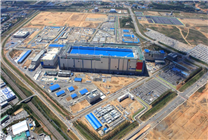Samsung’s Ambitious Expansion of 1cnm DRAM Production: Aiming for 200,000 Wafers Monthly by 2026
Summary
- Samsung targets a monthly production capacity of 200,000 wafers of 1cnm DRAM by the end of 2026.
- The planned production increase reflects Samsung’s confidence in market demand and technological advancements.
- Competitor SK Hynix is also set to begin mass production of 1cnm DRAM, signaling intensified competition in the sector.
Introduction
In a bold move to capitalize on the burgeoning market demands, Samsung has announced plans to expand its 1cnm DRAM production capacity significantly. This initiative aims to meet the growing needs of high-bandwidth memory (HBM) applications, especially in segments driven by artificial intelligence and data-intensive computing.
Production Goals
Samsung’s goal is to increase its monthly production capacity from the current levels to 140,000 wafers by the second quarter of 2026, and further up to 200,000 wafers by the fourth quarter of the same year. This ambitious expansion signifies a strategic response to the fast-evolving technological landscape and a commitment to staying at the forefront of semiconductor production.
Current Production Capacity
Currently, Samsung’s total DRAM production capacity hovers between 650,000 and 700,000 wafers monthly. The anticipated contribution of 1cnm DRAM will represent approximately 30% of this total capacity in the near term. This growth trajectory surpasses the previous expansion rate noted during the semiconductor boom in 2022, indicating Samsung’s forward-thinking approach.
Strategic Implementation
To achieve these production milestones, Samsung plans to implement a dual strategy: enhancing the existing DRAM production lines through technological upgrades and making significant investments in the P4 factory located in Pyeongtaek. This combination of internal improvements and new capital investment illustrates a robust commitment to achieving operational efficienc.
Market Dynamics
The aggressive expansion of 1cnm DRAM production reflects not only technological confidence but also a keen awareness of market dynamics. Recent trends indicate a persistent shortage in the DRAM market, particularly driven by rising needs in sectors involving artificial intelligence and machine learning technologies.
Competitive Landscape
Samsung’s competitor, SK Hynix, is also gearing up for a pivotal shift, planning to initiate mass production of 1cnm DRAM by 2025, with full-scale operations expected in 2026. SK Hynix anticipates that by the end of 2026, more than half of its domestic general DRAM production in South Korea will utilize the advanced 1cnm process, further intensifying competition in the semiconductor space.
Implications for the Industry
The concerted push from both Samsung and SK Hynix highlights a turning point in the semiconductor industry, characterized by a race to innovate and meet the demands of advanced applications. The fast-paced developments indicate that both companies are recognizing and adapting to the future of computing, where speed and efficiency are paramount.
Conclusion
Samsung’s strategic initiative to ramp up its 1cnm DRAM production capacity signals a significant commitment to advancing semiconductor technology and addressing market demands. As the industry continues to evolve, this expansion not only positions Samsung as a leader but also underscores the competitive landscape that will shape the future of data processing technology. The interplay between technological advancement and market demand will be keenly felt as these developments unfold in the coming years.
Through these efforts, Samsung is poised to solidify its place as a significant player in the semiconductor market, with a keen eye towards innovation and growth in the face of escalating competition.





